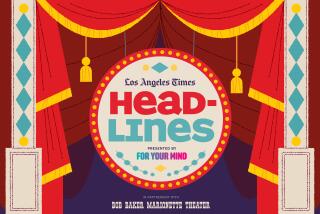Video Explains Deadly Disease : For Children, ‘A Is for AIDS’
- Share via
SAN FRANCISCO — “Andy Answer” is a cartoon dog in a medical lab coat who dispenses information about AIDS to school children.
He tells kids it’s OK to be around people who have AIDS, to play with them, hug them, and study with them, and he assures kids they needn’t worry about getting AIDS because they don’t share needles and aren’t ready to have sex.
“Andy Answer’ is the star of “A is for AIDS,” a new videotape for children that will be shown this spring to about 4,000 fifth-graders in the San Francisco Unified School District.
“If kids are playing ‘AIDS-tag’ in the playground, and they start thinking some guy’s going to give them AIDS by touching them, we have to do something about correcting it,” says Alissa Ralston, a member of the California Department of Education’s AIDS Advisory Committee.
Several other school districts around the country, including in California, Washington State, Montana, Indiana, Georgia, are considering the tape for children, some as young as second grade.
‘In Good Taste’
“We need to reassure young children who worry about AIDS because of the kinds of comments they hear adults making,” said Joan Haskin, administrator for health programs for San Francisco’s schools. “This videotape is very positive, in good taste with appropriate language.”
Charlotte K. Beyers, a journalist and video producer in Palo Alto, made “A is for AIDS” with co-writer and director Aron Ranen of Los Angeles after Surgeon General C. Everett Koop urged that AIDS education begin as early as elementary school.
“We haven’t been talking about AIDS very much at the fourth- and fifth-grade levels because it’s a sensitive issue,” says Roy Bueler, coordinator of the school library program for the 29,000-student Tacoma, Wash., Unified School District. “Everything we looked at was for older people in the workplace or in high school, but this tape looked pretty good for our students.”
In the videotape, Andy takes children on a trip inside a human body to explain how the disease works. Animated ugly germs with fangs attack armies of white blood cells led by mustachioed “generals,” or T-4 cells, that direct the body’s immune system.
The animation shows the panicked white cells overcome by germs, and Andy explains that it sometimes takes a long time for people with AIDS to become really sick.
Gives Explanation
“The AIDS virus destroys the immune system, leaving the body with no protection against disease. And that’s why many people with AIDS become very sick and even die.”
Dr. Roger Peeks, assistant dean at Stanford University’s Medical Center, appears on the tape to explain, with an air of authority, that AIDS cannot be caught by touching a person or a doorknob, by swimming, sitting on a bus or getting bit by a mosquito.
The tape does not refer to homosexuality. Its only hint that AIDS can be transmitted sexually is that the children in the tape, who are about 11 years old, “aren’t ready to have sex.”
The tape also features visits with two children--a 9-year-old girl in New York born with AIDS because her mother shared a needle with an AIDS victim, and 16-year-old Ryan White of Indiana, a hemophiliac who got AIDS from a blood transfusion. Both segments show the children surrounded by family and friends not afraid about catching the disease.
Of the 78,985 AIDS cases reported since 1981, 1,257 have been children under 13, including 1,020 under age 5, according to the Centers for Disease Control in Atlanta. There are 977 other children who have parents with AIDS or are considered at risk of getting the disease. More than 44,000 AIDS patients, or 56% of all cases, have died.
“It’s scary stuff,” said Ralston, who wrote a parents’ guidebook on AIDS. “You don’t want your kid walking around worried unnecessarily that they’re going to catch this disease. At the same time, you want to let them know what the risks are, like if you find a needle at the playground, you don’t touch it. That’s AIDS prevention for kindergartners.”
More to Read
Sign up for Essential California
The most important California stories and recommendations in your inbox every morning.
You may occasionally receive promotional content from the Los Angeles Times.













